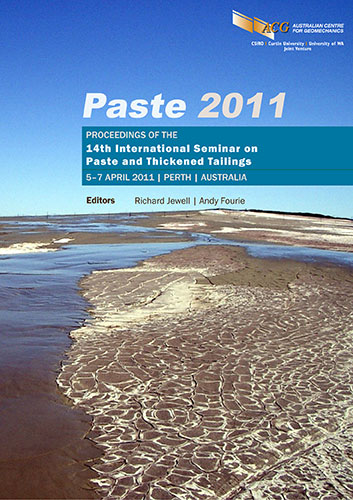Design and operational experience of the Cerro Lindo filtered tailings deposit

|
Authors: Lara, JL; León, E |
DOI https://doi.org/10.36487/ACG_rep/1104_03_Lara
Cite As:
Lara, JL & León, E 2011, 'Design and operational experience of the Cerro Lindo filtered tailings deposit', in R Jewell & AB Fourie (eds), Paste 2011: Proceedings of the 14th International Seminar on Paste and Thickened Tailings, Australian Centre for Geomechanics, Perth, pp. 25-37, https://doi.org/10.36487/ACG_rep/1104_03_Lara
Abstract:
Filtered tailings (FT) provides an alternative to surface tailings deposition that is being applied more frequently in areas in which availability of space and water is limited. FT can be applied in areas in which topographic, geotechnical and geodynamic conditions as well as seismic, climatic and rheological conditions of the tailings allow their implementation. Cerro Lindo Project (CLP) is located 200 km south of Lima-Peru in an area of limited rainfall and high seismic activity. The tailings deposit is located in a quebrada (ravine) with a moderate to high gradient, of the order of 20–25%, in a small basin less than 1 km2 in area. The project started operation in 2007 and currently processes 7,000 tpd to obtain polymetallic minerals (lead, zinc and copper); CLP produces tailings that are deposited on the surface and in underground mining. For surface deposition of tailings, the tailings are filtered by belt filters until 85% solids content is reached. Then the tailings are transported by trucks to the deposition area where they are placed in different zones in a cyclical manner to allow drying until the proper moisture content is achieved to allow compaction in layers. The deposited tailings are high in pyrite, with high specific gravity and of sandy silt particle size. This article shows design concepts and operational expertise gained over the past three years in the deposit management of filtered tailings of Cerro Lindo Mine. This is considered a unique and successful world class operation in the implementation of tailings dewatering, and in the application of friendly technologies with small impact on the environment and an operation that uses the water from the tailings dewatering process and also seawater for the operation of the mine.
References:
Golder (2006a) Hydrological Assessment of Cerro Lindo Project Area, Basic and Detail Engineering Study for the Filtered Tailings Deposit of Cerro Lindo Project, Chincha, Peru.
Golder (2006b) Assessment of the Seismic Hazard of Cerro Lindo Project Area, Basic and Detail Engineering Study for the Filtered Tailings Deposit of Cerro Lindo Project, Chincha, Peru.
Golder (2006c) Hydrogeological and Geological Assessment of Cerro Lindo Tailings Deposit Area, Basic and Detail Engineering Study for the Filtered Tailings Deposit of Cerro Lindo Project, Chincha, Peru.
Golder (2006d) Geotechnical Investigation of Cerro Lindo Tailings Deposit Area and tailings, Basic and Detail Engineering Study for the Filtered Tailings Deposit of Cerro Lindo Project, Chincha, Peru.
Milpo (2009) Geotechnical Investigations and Piezometer Installation at Pahuaypite Tailings Deposit, by Ingeodrilling H, SAC for Compañía Minera Milpo.
© Copyright 2025, Australian Centre for Geomechanics (ACG), The University of Western Australia. All rights reserved.
View copyright/legal information
Please direct any queries or error reports to repository-acg@uwa.edu.au
View copyright/legal information
Please direct any queries or error reports to repository-acg@uwa.edu.au